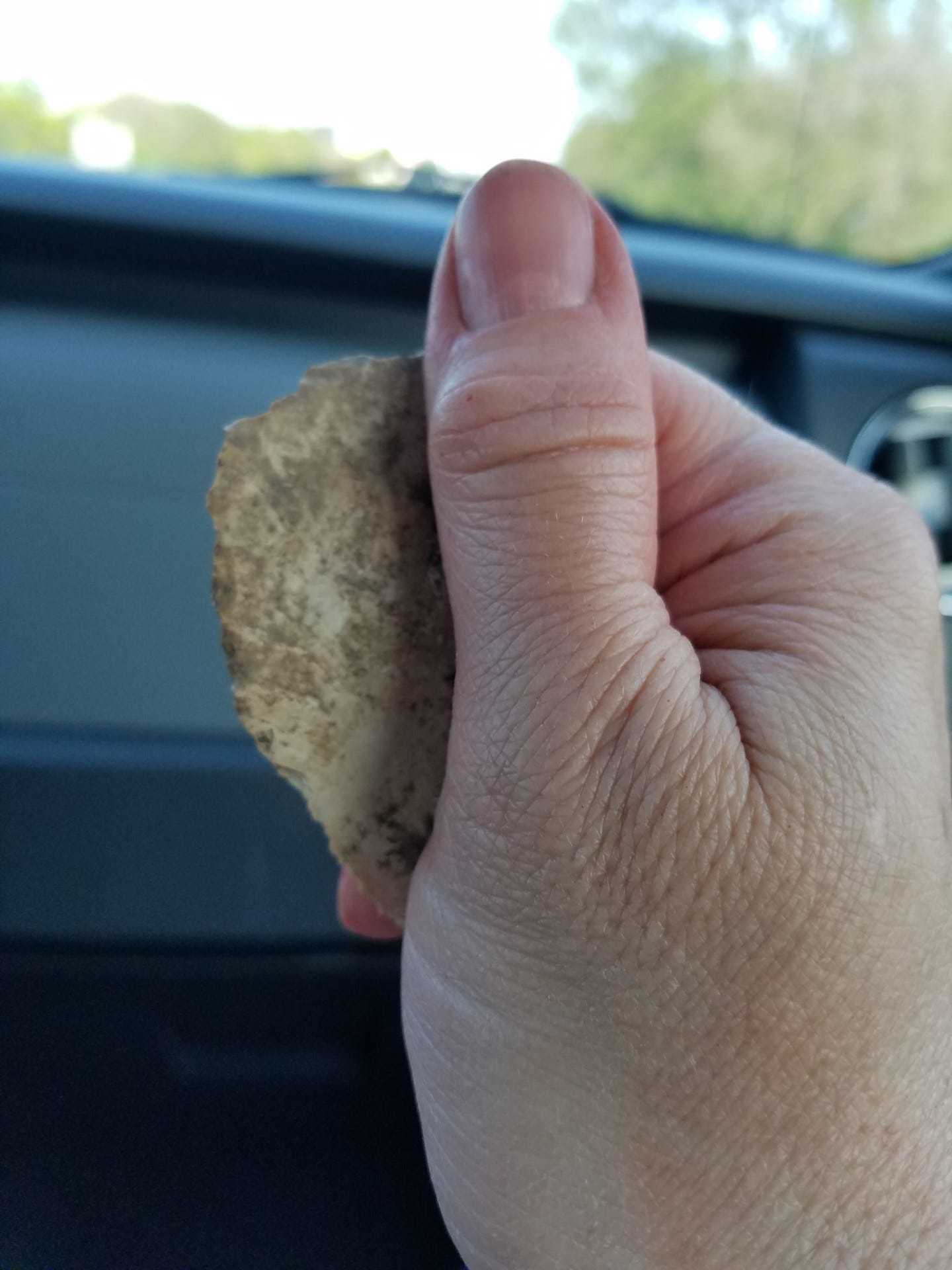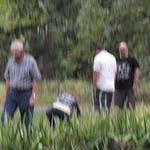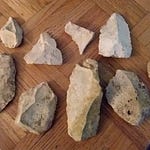“Now” is a popular word, one used frequently by impatient humans. What does it mean, and, more importantly, how long is now?
Note about the image: I found this stone along the creek and picked it up because it looked intentionally chipped along the one edge, plus it made a distinctive “chink” sound, identifying it as chert. On the way home I was surprised to find how well it fit into my hand. I suspected it was a scraping tool; a stone tool expert labeled it “prehistoric.”
My Mysterious Mind
I might need to issue some type of warning before I begin to unpack what has been going on in my mysterious mind lately. Traversing into profound territory with me, beyond human comprehension, might make your head hurt, metaphorically speaking. This adventure of reflection started when I read a deeply philosophical book, The Clock of the Long Now, written by Stewart Brand, published in 1999. This book, about really long term thinking, stretches the reader’s mind to consider one’s human existence in a 20,000-year time frame, half already past and half lying in the future. Brand is responsible for the Long Now organization and work on a clock under construction in the Sierra Diablo mountains in Texas. This clock will keep time for 10,000 years, allowing visitors to see their lives within an extended era of human history.
Now. How long is that? If you are like most modern people, “now” refers to this moment or, maybe, a bit longer. When a parent announces to a child, “we need to leave now,” that pronouncement signals the necessity of imminent departure. A text message query of “what are you doing now?” assesses current activity, such as “watching TV” or “making dinner.” Thinking of “now” as being a long period of time, such as proposed in the “long now” book, is weird to modern thinkers. How can “now” be long?
Humans of previous generations had a longer notion of “now.” A church might be working on building a cathedral, a “now” project that lasted centuries. The Cologne Cathedral in Germany took more than six-hundred years to finish; the St. Vitus Cathedral in Prague and the Milan Cathedral in Italy took slightly less than that (585 and 579 years, respectively). Modern construction projects are expected to be completed quickly, many torn down before reaching a century of age. The point of this comparison is to show how modern civilizations think of “now” as much shorter than previous generations.
Thinking “long term” for modern humans likely means pondering a future that is five years down the road, maybe a bit longer. Contemplating one’s epitaph is at the extreme of thinking long term for most of us. We are alive “now” and, one day in the future, we will not be, thereby stretching the notion of “now” to be the span of a human life. That is a “long now” to consider, but a mere blip of time compared to Brand’s recommendation of 10,000 years.
I warned you the topic of “now” was a mind-bender. Brand, drawing on the view of ancient Greeks, distinguished two kinds of time, and, therefore, two types of “now.” The first is “kairos,” the propitious moment or short now; the second is “chronos,” ongoing time or the long now. Greeks proposed being clever in the now of kairos, but being wise in the now of chronos. Put more simply, actions should be considered for their short term and long term consequences, the now and the long now. Choices have immediate impacts, but their ultimate outcomes could prove far more significant. What you do now matters now, both the short and long versions.
Message from Mystery Acres
One of the mysterious and beautiful benefits of a trip to the same few acres of forest is the stretching of time. Being in the woods makes “now” seem longer than in the concrete and asphalt jungle of modern life. The same trees surround me, living in a longer now than my life’s span. At night I can gaze at light that has traveled from stars more light years away than I can comprehend. I can marvel at wildflowers blooming in patterns across multiple seasons, no knowledge of when they were first growing, and no concern for when their lives will end. Now, in the forest, is a lovely, magical, long time.
The forest provides evidence of people who have lived before me. The shaped trees whisper of indigenous people who bent them as communication devices, “our elders are buried here” or “this way to the village.” Even more subtle murmurs can be detected from strange stones found lying in the creek bed. Their shapes stretch the “now” of humans who previously existed. An expert on stone tools told me some of the stones I have found are “pre-historic,” dating back several thousand years. Other people, now gone, used to be here.
There’s something oddly comforting about experiencing the transience of my own life. The message of Mystery Acres is to slow down and allow the sense of “now” to lengthen. Now is more than a mere moment, it’s part of a longer strand of existence of which we are each a small part. The forest helps connect the fibers weaving generations of us together.
Ancient Mystery’s Voice
Jesus said, “Now I say to you…you cannot follow me now.” (John 13: 33, 36)
The word “now” is used over twelve-hundred times in the English translations of the Bible. Digging into the original Hebrew used in the Old Testament and the original Greek used in the Old Testament, I was surprised to find at least eighteen different words had been translated into the word “now” (9 in the Hebrew; 9 in the Greek). I quickly realized our word for “now” was not sufficient to capture the same meaning intended by ancient scriptures. Given my extremely limited knowledge I concluded an extensive, and better informed, study of this word was warranted for even adequate conclusions to be drawn.
Nonetheless, I chose one small section of the book of John where Jesus used two of the most common Greek words translated into the word “now.” In verse 33, Jesus used a Greek word that means “at this moment,” or “this day.” In verse 36, the word He chose is better translated “at the present time.” Inserting these meanings into the selected verses, Jesus said, “Today I say to you… you cannot follow me during the present time.” Peter asked Jesus why he couldn’t follow now; Peter used the “today” version of now, typical of the short-term thinking of humans. In this exchange, we can see two very dissimilar definitions of “now.” The first is a moment; the second is a vague, longer amount of time.
Which got me thinking about a novel, written by an author. Having written the entire story, the author can point to something happening in a given chapter and use the word “now” to refer to a point in the flow of the story. That same author can use the word “now” to indicate the status at the end of the entire story. More likely, however, the author would refer to a point in the story as “in this chapter” and the conclusion as “how the story ends.” The one who wrote the book exists “outside” of the story. The characters within the story have moment-by-moment “nows,” as do the readers of the story. The author of a story exists outside of the story and its timeline. We read the story and it is as though events are happening one at a time. To the author, everything happened at once, as an entire story.
I took this tangent because I am trying to comprehend what length of time Jesus was referring to when He said the disciples couldn’t follow Him yet. He went on to say they would be able to follow him later, using a Greek word that means “at the last of all.” Jesus spoke like the author of a book, saying something like: “In this sentence (now) I am saying you cannot follow me in this book (long now), but, at the end of the book (at the last), you will follow Me.”
Jesus spoke like an author because He is THE author. As part of God, He is the “Alpha and the Omega,” the entire Greek alphabet, the whole story He “wrote” about humanity and all of creation. To the author, existing outside of the time line of the story, it is as though the whole story has already happened. This is true of creation’s story AND for every one of our stories within that big, master story. Jesus, as a crucified and risen being, existed before/outside of the human timeline. Yahweh, the first name God gave for Himself, already included the completed work of Jesus in His name, outside of time itself. As I described in “I am…” the pictorial translation of Yahweh is “behold the hand; behold the nail.” For the Creator and Author, the “big story” is already written.
Have you ever watched movie or read a book and noticed hints as to how the story was going to end? This foreshadowing is a popular technique for story writers. Foreshadowing in the Bible is called prophecy. God, the author, gave clues to prophets about the upcoming parts of the story. Jesus, as God, also gave clues as to how the story would end and where His followers would be then. In the words of Ancient Mystery I chose for this contemplation of “now,” Jesus prophesied that His disciples would go where He was going at the end of the story He had written. They would follow Him to a place outside of “now.”
Living in Mystery
What does it mean to live in the mystery of an extended sense of now? First, it compels us to spend more time in wonder, immersed in a knowledge of a reality we cannot fully know. We are each a tiny part of something bigger than we can imagine. There’s something humbling and horrible about that. But pondering this mystery pushes more into the moment we call now, helping each of us to live more completely.
I believe I am part of a Grand Story, written by the Great Author. It’s a bit like Harold and His Purple Crayon, a popular children’s story about a little boy whose drawings became real. Except that was a story about a child and simple children’s drawings. I’m suggesting something far, far more spectacular. And I am encouraging you to believe as I do, relishing your small part in a massive, amazing story of humanity and salvation. If I’m right, then I was meant to write these words and you were meant to read them. That connects us to each other and both of us to something larger than we can conceive.
Do you trust the Great Author to have written a good ending to your story? If so, thank Him now, in your now, for what He has already written into His story for you and about you. Trust the “author and perfecter of your faith” (see Hebrews 12:2). In a well-written story, the author foreshadows the outcomes for the characters, helping us to “sense” what is coming. Tune into the good on its way to you during the chapters when it hasn’t yet been fully revealed to you. Keep turning the pages until what you hope and trust is true becomes true for you. The good planned has already been written into your story by the Great Author. Good writers use difficulty in the lives of their characters as part of a good plot. Characters grow from struggle. Good human writers model their writing after the Great Author. He uses tough experiences to develop the people, us, who He writes into His Grand Story.
As an old mom to young parents, I invite you to think about how you can’t imagine life without your child. It’s as though you’ve always had that child as part of your life – because you have. In the Grand Story, written by the Great Author, this child was written into your story, just as you were written into the story of your parents. There is a Master Plan at work here, one beyond our comprehension. Relax and enjoy your story as parents. It has its ups and downs and crazy plot twists, but the chapters were written with the greatest love for you and your children.
We can’t comprehend all of this, and yet it makes sense to us. Living in the mystery of the “long now” means cherishing our part in a majestic story, spanning numerous generations, including ours. Now is a part of so much more, of something so magnificent. Rejoice with me in being part of it!
Connecting With Mystery
Dear Lord of All Mystery, I confess to being focused on a short now, often unaware of the longer now you have orchestrated for me. Help me to notice the hints you sprinkle into my story of the good you are assembling in the future chapters of my life. Thank You for writing my story; grow my trust in Your goodness as the Great Author. Amen.
Notes from Dr. Mac
If you want to do your own investigation of any of the scriptures I use, I suggest you go to Bible Gateway. This free online version of the Bible allows a search of words or phrases in various translations. You might enjoy reading the larger context of the thirteenth chapter of John. If you really want to stretch your brain, I suggest you grab a used copy of Brand’s book. Take a long time to read it, a little bit at a time.
You can find previous posts and podcasts in my ARCHIVE and organized compilations in the My “Books” section. You can also find Mystery’s Voice on Spotify .
Do you have thoughts to share? Please leave a comment below or through the Substack App, or email me privately at Dear Dr. Mac. I love to hear from you!














Share this post